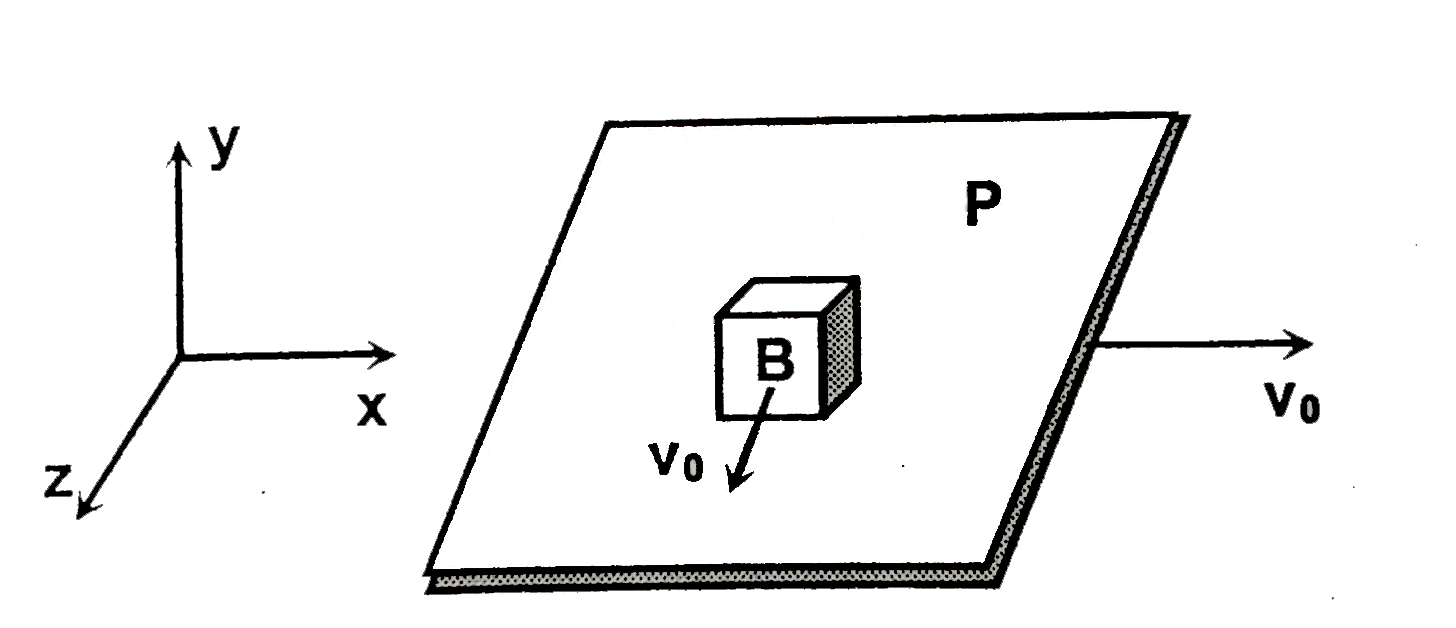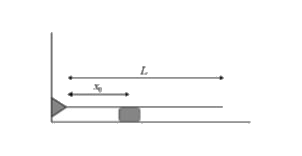A very large plank P of some unknown mass is being moved with velocity v0ˆi under application of an external force (not shown in figure). Simultaneously a block B of mass m placed on the plank is also moving with velocity v0ˆk. All these velocities are with respect to ground frame and at t=0. Coefficient of frictioin between the plank and the block μ. Choose the correct option(s).

Kinetic friction force acting on the block at t=0 is −μmgˆk
At t=0, power developed (with respect to ground frame) by kinetic friction force on the block B is −μmgv0√2
At t=0 power developed (with respect to ground frame) by kinetic friction force on the block B is −μmg√2v0
At t=0, heat dissipation per sec in the system is 2√2μmgv0
The correct Answer is:B, C
→fk on the block B=μmg(1√2ˆi−1√2ˆk)
Pfk=μmg[ˆi√2−ˆk√2].(v0ˆk)
=−μmgv0√2
dQdt=μmgv02√2=√2μmgv0
Topper's Solved these Questions
- TEST PAPERSBOOK - FIITJEECHAPTER - TEST PAPERSEXERCISE - PHYSICS
747 Videos
- SIMPLE HARMONIC MOTIONBOOK - FIITJEECHAPTER - SIMPLE HARMONIC MOTIONEXERCISE - Assignment Problems (Objective) (Level-II)
20 Videos
- WORK, ENERGY AND POWER BOOK - FIITJEECHAPTER - WORK, ENERGY AND POWER EXERCISE - COMPREHENSIONS ( Comprehension-II)
5 Videos
Similar Questions
A plank of mass M is placed on a rough horizontal surface. A man m walks on the plank with an acceleration 'a' while the plank is also acted upon by a horizontal force F whose magnitude and direction can be adjusted to keep the plank at rest.
The coefficient of friction between plank and surface is μ. Choose the correct options.
 .
.
View SolutionA plank of mass M is moving on a smooth horizontal surface with speed 'v0'. At t=0 a sphere of mass 'm' and radius 'r' is gently placed on it and simultaneously a constant horizontal force 'F' is applied on the plank in the opposite direction of v0. Find the time at which sphere starts rolling on the plank. The coefficient of friction between the plank and the sphere is μ.

View Solution
Knowledge Check
A block of mass m is placed gently onto a long plank of mass M moving with a velocity v0 on a smooth horizontal floor. If friction is present between M and m :
 Avcentre of mass=Mv0M+mBWfriction on m is positiveCWFriction on M is negativeDfinal velocity of both =mv0m+M
Avcentre of mass=Mv0M+mBWfriction on m is positiveCWFriction on M is negativeDfinal velocity of both =mv0m+MA plank is moving on ground with a velocity v and a block is moving on the plank with respect to it with a velocity u as shown in figure. What is the velocity of block with respect to ground ?
 Av−u towards rightBv−u towards leftCu towards rightDnone of these
Av−u towards rightBv−u towards leftCu towards rightDnone of theseA plank of mass M is placed on a rough horizontal surface. A man m walks on the plank with an acceleration 'a' while the plank is also acted upon by a horizontal force F whose magnitude and direction can be adjusted to keep the plank at rest.
The coefficient of friction between plank and surface is μ. Choose the correct options.
 .AThe maximum value of F to keep plank at rest is ma+μ(M+m)gBThe minimum value of F to keep the plank at rest is ma−μ(M+m)gCThe direction of friction on ground due to plank will always be forwardDIf F=ma then friction on man due to plank is also F and friction between plank and ground will be zero
.AThe maximum value of F to keep plank at rest is ma+μ(M+m)gBThe minimum value of F to keep the plank at rest is ma−μ(M+m)gCThe direction of friction on ground due to plank will always be forwardDIf F=ma then friction on man due to plank is also F and friction between plank and ground will be zero
A thin but very large plank of mass 2 m is placed on a horziontal smooth surface. A solid cylinder of mass m and radius r is given only translational velocity v0 and gently placed on the plank as shown in the figure. The coefficient of kinetic friciton between the plank and the cylinder is μ.

View SolutionA ring of mass m having velocity v0 is placed on a long plank lies on smooth horizontal surface at time t=0 as shown. Find the time when the ring start pure rolling on the plank. [μ is coefficient of friction between the ring and the plank.]

View SolutionA block of mass m=2kg is placed in equilibrium on a moving plank accelerating with a=4m/s2 . If coefficient of friction between plank and block μ=0.2 . The friction force acting on the block is:
View SolutionA block of mass m=2kg is placed in equilibrium on a moving plank accelerating with a=1m/s2 . If coefficient of friction between plank and block μ=0.2 . The friction force acting on theblock is:
View SolutionA block of mass m is kept on a smooth surface. It is also in contact with a thin plank of mass M=2m, one end of which is clamped to a wall as shown in the figure. The length of the plank is L. The block is given an initial velocity v0, towards right and initially the block is at a distance x0 from hinge. Coefficient of friction between the plank and block is μ.
Assume that througout the motion block remains, below the rod, then at what position from the fixed point it will stop?
(GIven β=v202μgL)

View Solution
